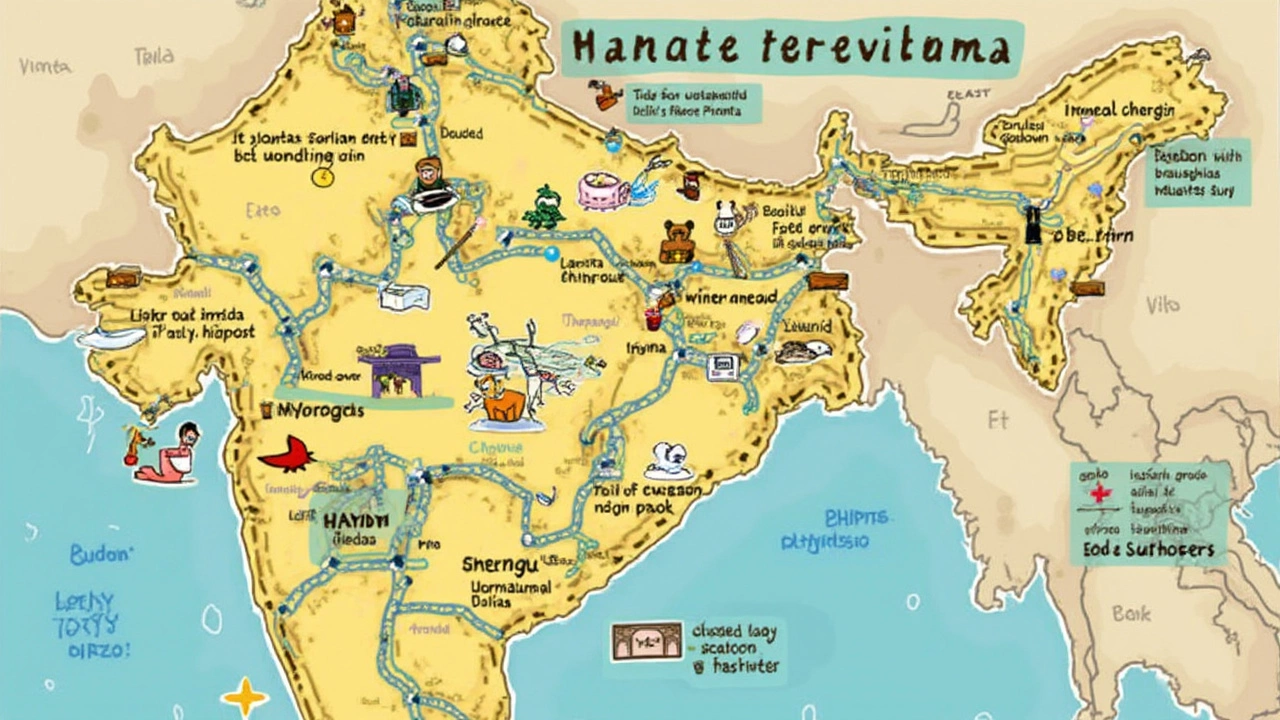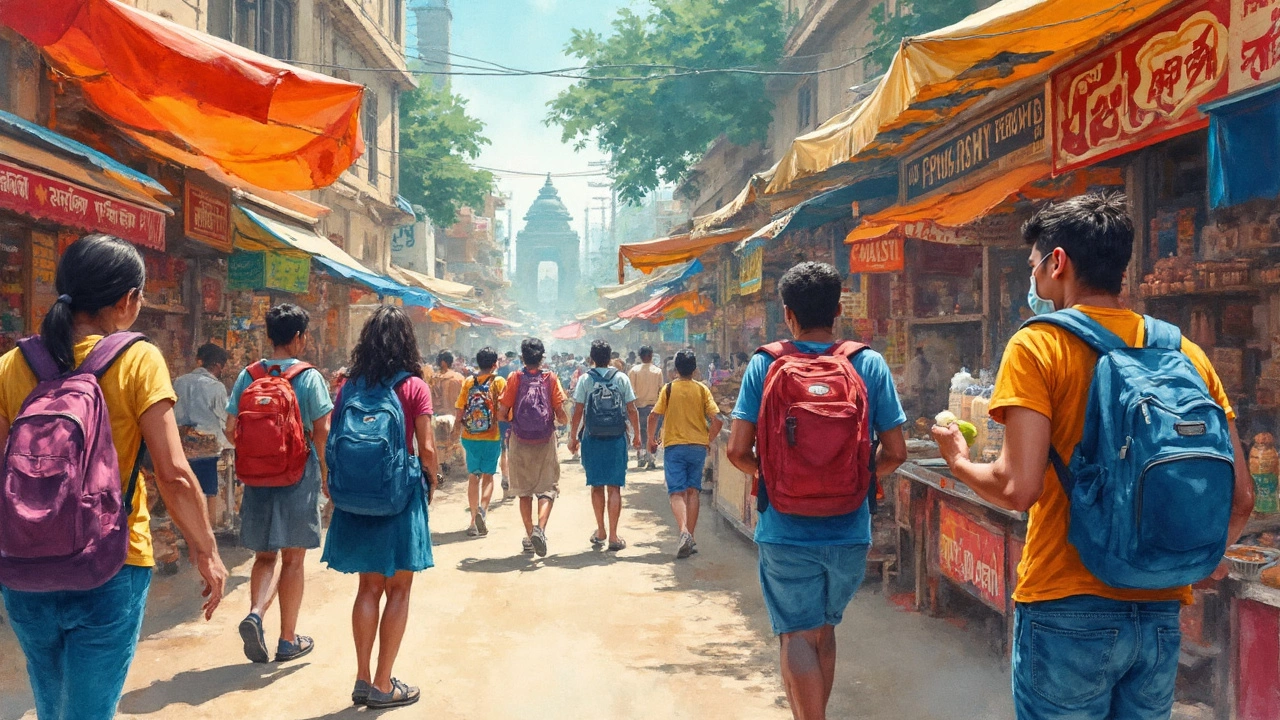Traveling to India on a budget is a fantastic adventure, but it comes with its own set of challenges—like the infamous Delhi Belly. How long does it take to shake off this unwanted travel buddy? Let's dig into it.
First off, Delhi Belly isn't some mythical creature; it's just a funky term for a mild case of traveler's diarrhea that often strikes foreigners. The good news? Most folks find it passes within 24 to 72 hours. But a word to the wise: It can sometimes linger, demanding extra patience and care.
What's behind this discomfort? Often, it's your digestive system reacting to new bacteria in food or water, which is pretty common when you hop across borders. With mild dehydration and discomfort, it could be a few days of sticking close to a restroom.
To recover faster, keeping hydrated is the name of the game. Regular sips of clean water or rehydration solutions work wonders. Avoid street food temporarily and focus on bland, easily digestible options like rice and toast.
Of course, prevention is better than cure. Before you even set foot on Indian soil, consider getting accustomed to local spices and flavors gradually. Once there, eat where the locals eat—they often know the safest places. A travel tip: always wash your hands before meals to limit bacteria exposure.
- Understanding Delhi Belly
- Common Causes and Symptoms
- Effective Remedies
- Prevention Tips
- When to Seek Help
Understanding Delhi Belly
So, what exactly is Delhi Belly? It's a term used to describe the digestive troubles travelers often face when visiting India. These traveler's diarrhea woes aren't unique to India but tend to happen more there due to the change in diet and water.
What's Causing the Trouble?
The main culprits behind Delhi Belly are different bacteria, viruses, or parasites that your stomach isn't used to handling. These might be found in tap water, unwashed fruits, or street food that might not meet the hygiene standards your belly is accustomed to.
Commonly, E. coli and other bacteria found in contaminated food and water are the troublemakers here. It's worth noting that locals usually don't experience these effects as their systems are adapted over time.
Recognizing the Symptoms
The symptoms you might encounter include frequent loose stools, stomach cramps, nausea, and sometimes fever. Often it's nothing to panic about, but it can feel pretty uncomfortable.
- Frequent trips to the bathroom
- Feeling queasy or having nausea
- Stomach tightening or cramping
- Occasional fever or general tiredness
Your Body's Reaction
It's basically your body's 'Welcome Party' for foreign bacteria. Your immune system is doing its best to kick these new visitors out, hence the symptoms. The reaction can differ from person to person based on immune strength and previous exposure to these microbes.
About 30-70% of international travelers report experiencing some form of traveler's diarrhea within their first two weeks, according to various health studies.
| Factor | Chance of Getting Delhi Belly |
|---|---|
| Trying Street Food | High |
| Drinking Tap Water | Very High |
| Eating at Trusted Restaurants | Lower |
Common Causes and Symptoms
You might wonder why travelers often talk about Delhi Belly like it's an unavoidable rite of passage. So what are the culprits? It usually boils down to a mix of bacteria, viruses, or even parasites that your gut isn't used to tackling. One major cause is contaminated food or water, which might not sit well with your tummy.
Usual Suspects
- Contaminated Water: Tap water in many parts of India isn't always safe for drinking, leading to issues if consumed or used with food.
- Street Food: While delicious, street food could sometimes be prepared in less-than-ideal sanitary conditions.
- Unwashed Produce: Fruits and veggies might not be washed thoroughly, introducing unwanted bacteria.
- Traveler's Bacteria: New microorganisms your system isn't used to can cause short-term tummy troubles.
Spotting the Symptoms
How do you know when you've been hit by Delhi Belly? Here’s what to look out for:
- Frequent Diarrhea: More loo trips than usual, often continuing for a couple of days.
- Nausea and Vomiting: A less-than-pleasant duo that can accompany diarrhea.
- Stomach Cramps: Sudden aches and cramps can be another indicator.
- Mild Fever: Your body's way of fighting off those unfamiliar bugs.
- Dehydration: Dryness and fatigue due to fluid loss.
Overall, the key is to keep calm and monitor your symptoms. If they persist beyond a couple of days or seem severe, it might be time to seek medical advice. A handy stat to keep in mind: according to recent traveler surveys, around 30-50% catch some form of traveler's diarrhea at some point. So, you're definitely not alone in this!

Effective Remedies
If you find yourself struck down by Delhi Belly, don't panic—there are plenty of ways to get back on your feet. Here are some practical remedies that have worked for many travelers.
1. Stay Hydrated
When you're dealing with traveler's diarrhea, fluids are your best friend. Keep yourself hydrated by sipping on water regularly. Adding oral rehydration salts to your drinks can help replenish both fluids and electrolytes quickly. You might find these salts locally, but if you can, pack a few sachets before your trip.
2. BRAT Diet
Introduce the BRAT diet into your meals—Bananas, Rice, Applesauce, and Toast. These foods are gentle on your tummy and can help firm things up. While Delhi's street food might be tempting, aim for bland meals until your stomach settles.
3. Probiotics
Probiotics can aid in restoring balance to your gut flora. Consider taking a capsule form, or introduce probiotic-rich foods like yogurt into your diet. They're easily found in most grocery stores, and they provide that extra gut protection.
4. Antidiarrheal Medications
Medications like loperamide are often effective. They provide quick relief from urgent restroom trips. However, use them sparingly—you don't want to mask symptoms if your body is trying to clear something out. Consult a healthcare professional if you're unsure.
5. Rest
Your body needs time to recover, so give it the rest it deserves. Try to keep stress levels low, sleep well, and avoid intense activities. This downtime will speed up your healing process.
| Remedy | Effectiveness |
|---|---|
| Hydration | High |
| BRAT Diet | Moderate |
| Probiotics | Varies |
| Antidiarrheal Meds | Quick Relief |
| Rest | Essential |
If symptoms persist longer than the usual 72 hours, it's wise to consult a local doctor. Getting over Delhi Belly is usually straightforward, and with these remedies, you'll be back to exploring India, budget travel style, in no time.
Prevention Tips
Avoiding Delhi Belly can make your trip to India a whole lot smoother. With a few simple tricks, you can reduce the risk of this pesky stomach issue.
Mind What You Eat and Drink
One of the easiest ways to stay clear of traveler's diarrhea is by being a bit choosy about what goes into your mouth. Here's the scoop:
- Stick to Bottled Water: Always choose bottled water over tap. Double-check the seal before purchasing.
- Opt for Cooked Foods: Go for meals that are freshly cooked and served hot. Heat kills bacteria, offering a safer dining choice.
- Peel It or Leave It: If you can't peel it—like with bananas and oranges—it's better to skip it. This minimizes exposure to potential contaminants.
Smart Hygiene Practices
A little cleanliness goes a long way. Keep these tips in mind:
- Carry Hand Sanitizer: Use it before meals if soap and water aren't available.
- Wash Fruits and Vegetables: If you buy fresh fruits or veggies, make sure to wash them with clean water before eating.
Supporting Your Gut Health
Your body needs time to adjust to new bacteria, so give your stomach a helping hand:
- Probiotics Can Help: Consider taking probiotics a week or so before your flight. They can prep your gut to handle new bacteria better.
- Stay Hydrated: Besides aiding overall health, proper hydration helps your digestive system work effectively.
Follow the Locals
As a general rule of thumb, eating where locals eat can actually be safer. They know where to find tastier, safer meals.
Keep these tips in your travel toolkit, and you're more likely to dodge the discomfort of Delhi Belly, letting you focus on enjoying your Indian adventure even on a tight budget!

When to Seek Help
While most cases of Delhi Belly are mild, knowing when to seek help is crucial to ensure your trip doesn't turn into a hospital visit. Let's break down some red flags that shouldn't be ignored.
Persistent Symptoms
If your upset stomach lasts more than three days or if symptoms worsen, it might be time to see a doctor. Persistent diarrhea can lead to severe dehydration—a risk you don't want to take lightly, especially in hot climates.
Severe Dehydration
Look out for signs like extreme thirst, dry mouth, or dizziness. If you experience these, seek medical help immediately. Severe dehydration can sneak up on you faster than you'd think. A handy tip: monitor your urine color; darker tones mean you're probably not drinking enough.
High Fever or Blood in Stool
High fever or spotting blood in your stool signals something more serious than simple traveler's diarrhea. These symptoms can point to bacterial infections that need medical intervention, often requiring antibiotics.
Unbearable Abdominal Pain
We all know an uncomfortable belly is par for the course with Delhi Belly. But if you're doubled over with severe pain, it's time to consult a professional. Unusual pain might indicate a different issue requiring immediate attention.
Don't shy away from using travel insurance to get checked by a local doctor—better to be safe than sorry!
